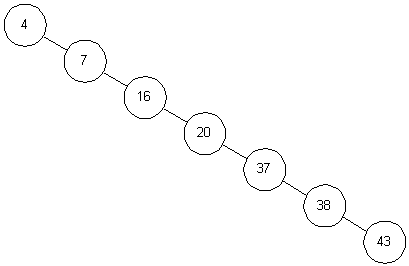Binary search tree: find: Difference between revisions
No edit summary |
|||
| Line 1: | Line 1: | ||
[[Category:Binary_Search_Tree]] | [[Category:Binary_Search_Tree]] | ||
[[Category:Algorithm]] | [[Category:Algorithm]] | ||
<div class="plainlinks" style="float:right;margin:0 0 5px 5px; border:1px solid #AAAAAA; width:auto; padding:1em; margin: 0px 0px 1em 1em;"> | |||
<div style="font-size: 1.8em;font-weight:bold;text-align: center;margin:0.2em 0 1em 0">Binary Search Tree</div> | |||
<div style="font-size: 1.2em; margin:.5em 0 1em 0; text-align:center">[[Sorted sequence]]</div> | |||
<div style="font-size: 1.2em; margin:.5em 0 .5em 0;text-align:center">[[File:olw_logo1.png|20px]][https://openlearnware.tu-darmstadt.de/#!/resource/binary-search-tree-1938 Openlearnware]<br>See Chapter 2,3</div> | |||
</div> | |||
== General Information == | == General Information == | ||
Revision as of 09:25, 1 October 2014
General Information
Algorithmic Problem: Sorted Sequence:find
Type of algorithm: loop
Auxiliary data: A pointer p of type "pointer to binary search tree node of type [math]\displaystyle{ \kappa }[/math]".
Abstract view
Invariant: After [math]\displaystyle{ i\geq 0 }[/math] Iterations.
- The pointer p points to a tree node v on height level i (or is void).
- The key K is in the range of v.
Variant: i is increased by 1.
Break condition: Either it is [math]\displaystyle{ p = void }[/math] or, otherwise, [math]\displaystyle{ p.key = K }[/math].
Induction basis
Abstract view: Set p:= root.
Implementation: Obvious
Proof: Nothing to show
Induction step
Abstract view: If p points to a node but not with key K, p descends in the appropriate direction, left or right.
Implementation:
- If [math]\displaystyle{ p = void }[/math], terminate the algorithm and return false.
- Otherwise, if [math]\displaystyle{ p.key = K }[/math], terminate the algorithm and return true.
- Otherwise:
- If [math]\displaystyle{ K \lt p.key }[/math], set [math]\displaystyle{ p := left }[/math].
- If [math]\displaystyle{ K \gt p.key }[/math], set [math]\displaystyle{ p := right }[/math].
Correctnes: Obvious.
Complexity
Statement: Linear in the length of the sequence in the worst case (more precisely, linear in the height of the tree).
Proof: Obvious.
Pseudocode
TREE-SEARCH (x, k)
- if x= NIL or k = key[x]
- then return x
- if k < key[x]
- then return TREE-SEARCH(left[x], k)
- else return TREE-SEARCH(right[x], k)
